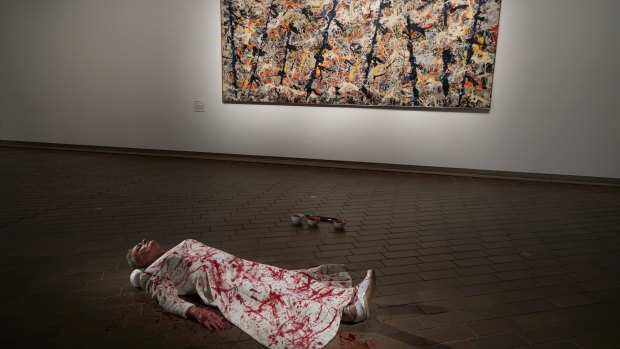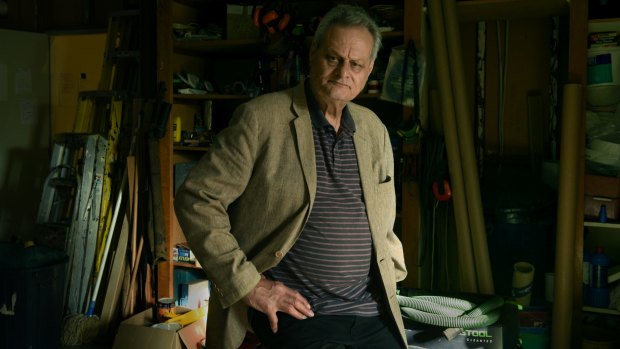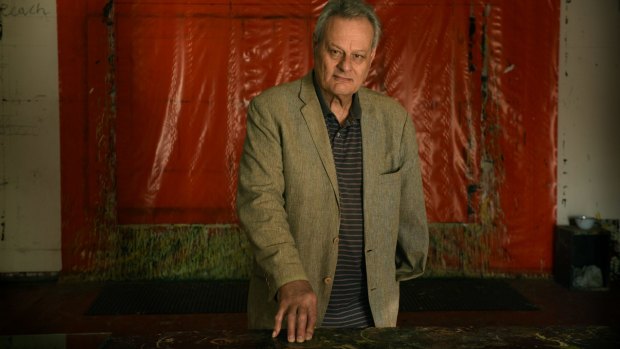This was published 8 years ago
Mike Parr: The extreme performance artist at pains to make his point
Mike Parr has had his face sewn up, nailed his arm to a wall, and been spattered with his own blood. What is it like being Australia's most extreme artist?
By Nick Galvin
Meeting Mike Parr for the first time, it's impossible to know what to expect.
Here is Australia's most lauded performance artist who has had his face sewn into a grotesque rictus with crisscrossed sutures, nailed his arm to a wall for 30 hours and, most recently, been spattered with large volumes of his own blood while lying motionless on the floor wearing a white dress.
But the figure who comes to the door of the airy and comfortable studio cum apartment in Alexandria could scarcely be more at odds with the intense and often violent performances for which he has become famous.
Wearing his habitual grey jacket with the empty left sleeve tucked in the pocket the 71-year-old is a generous and solicitous host, happily taking direction from the photographer before leading us into his small office crammed with art history books.

Mike Parr's recent performance at the National Gallery of Australia involved being spattered with his own blood in front of Jackson Pollock's Blue Poles.Credit: Zan Wimberley
He is keen to show off on the computer screen a series of photographs of the blood-spattering performance he has just done at the National Gallery of Australia that have just arrived from photographer Zan Wimberley.
"Aren't they marvellous," he enthuses before we return to the kitchen for a pot of tea and a plate of biscuits.
Parr grew up around the NSW/Queensland border in a childhood dominated by his father, who had returned deeply traumatised from fighting in PNG.
There were a series of failed business ventures that sent the family into a downward spiral. Among other ideas, his father opened the first laundrette in Lismore. It lasted two years.

Being Mike Parr:Foreign Looking at the NGA surveys 50 years of his work.Credit: Steven Siewert
"I don't know what he was thinking," smiles Parr. "No one in Lismore was ever going to put their underwear on display."
Then there was a banana crop lost to a cyclone and a small mixed farm near the Gold Coast, which his father drove into the ground. "He didn't have a clue," says Parr.

Primitive Gifts, a 2006 performance by Mike Parr.Credit: National Gallery of Australia
In the late 1960s the bank foreclosed and for a while the family ended up living in a tent. "It was very complex and as I grow older it becomes more complex in my mind," says Parr of his memory of those years.
It was about this time that Parr staged what he now views as his first performance piece, pushing back against the local bullies' taunts.
"When they bailed me up and accused me of having one arm I used to invent stories," he says. "I'd say very coldly and calmly that I'd got it caught in the chaff cutter and it got mangled up with the banana stems that we fed to the cattle. The kids would all recoil in horror – it was my way of controlling a situation and carving out a distinct space for myself that I could then inhabit and in a way restore my dignity."
This act of "pushing back" those who witness his performances in order to give himself space was to become a constant theme.
His earliest formal performance work in front of an audience came about almost by accident at the end of a Sydney art show in 1972.
One work in the show was a sign reading: "Let a friend bite into your shoulder until blood appears".
"I decided to arrange to perform the work," says Parr. "We didn't really have a name for what we were doing and neither I nor the audience really understood what was happening.
"Peter Kennedy [a colleague in the artist collective Inhibodress] rolled up my sleeve, picked up my arm and started biting as hard as he could. It was incredibly painful but I realised in a flash that if I started emoting I would lose control of the situation. The people there would be all over me and someone would ring for a doctor or whatever.
"I had to just remain composed and control all my reactions. I had to maximise the tension and create a kind of invisible wall between me and the audience. It was that process of experiencing that detachment and self-control that became the basis of me doing performances."
All Parr's work begins with an idea that is reworked and refined until it is as clear as he can make it. The idea has to have a "certain density and relevance" to be worthy of pursuit. Then he often adds an element of endurance as another parameter.
He offers as an example an upcoming performance he is planning for Canberra. He has taken the first page of Camera Lucida, a short work by French philosopher Roland Barthes, and substituted each key noun over and over with synonyms. He will read the resulting work over the course of five or six hours.
"That one page is turning into a script of about 100 pages. This extraordinary drift happens through the text as I drift away from the original meaning by constantly substituting a synonym of the proceeding word and a synonym of that."
And as he sits in a clinically sparse setting reading the piece his voice will begin to fail, becoming hoarse and strained. As ever, he hopes at this point a level of clarity and realisation may occur.
"People sometimes say to me, 'Why are the performances so extreme'," he says. "And I say they are the way they are because they enable me to think. But when I do the piece it is sort of cathartic and I am flooded with a kind of awareness that doesn't exist before the performance. It allows me to organise memories and experiences that can't be organised in the absence of doing those things."

Working from ideas ... Mike Parr in the studio at his Alexandria home.Credit: Steven Siewert
But while Parr is best known for his performance pieces, there is also a vast body of other work from poetry to sculpture and drawing to print-making. That staggering diversity of output is well represented in the present survey exhibition Foreign Looking, a tightly edited representation of Parr's thinking.
"I think I have probably over-produced," he says. "I've done an enormous amount of work in the last 50 years."
One of the reasons is the quite practical point that because he never charges people to attend his performance work – an "aristocratic position" that allows him total artistic freedom – he has to pay the bills with work such as print making.
"It's very schizophrenic being an artist and trying to be an innovator as an artist in a culture like this," he says. "Because you've got to survive. I had to earn a living. The exhibition reflects that. I had to become good at a lot of things and not just concentrate on avant gardism."
However, the economic imperative can only go so far when faced with Parr's remorseless and rigorous self-examination, as gallerist Anna Schwartz found at a major show staged last year in Sydney called Deep North.
The show featured monumental prints that had taken two years to create and several had been sold in advance. "But from the moment the exhibition opened I started to feel uneasy," says Parr. " I started to feel that these prints were bombastic or something. They started to look back at me and I became increasingly uneasy."
So he rang Schwartz and announced he wanted to paint out the works on the final day of the show, potentially rendering them worthless. "In the end it was a sort of euphoric night. It was the return of the good old days in a funny kind of way."
The resulting monochromes are included in the Canberra show and, ironically, the result is aesthetically striking – an opinion shared by the collectors who continued with their purchase, says Parr.
It's not the first time Parr has "completed" works by painting them out. In 2014 he was invited to exhibit at an adjunct show to the Liverpool Biennial in Britain. He was unclear as to the finer details but when he arrived he was horrified to discover he was being feted as a disabled artist.
"It was utterly confusing to me," he says. "I completely rejected it and I became more and more disturbed."
His response was once again to paint out his work in a performance entitled, none-too-subtly, Unconscious Filled With Wheelchairs.
Parr insists having just one arm has been "an enormous advantage" and that the trajectory of his career would have been very different had it not been the case.
"I feel no reason why I should be identified as disabled," he says. "In fact, I feel exactly the opposite. My experiences of being different have deeply inflected my work but my work is not a form of victimhood, it is a tremendous self-assertion and a tremendous struggle for clarity and communication."
Parr's performances are often wordless and deliberately so, but in private he is happy and eager to explain the thinking behind a career of some 50 years. In listening, I'm reminded of something that was said about jazz genius Charlie Parker and his frenetic and dense solos. When Bird's sax recordings were slowed down they revealed themselves to make perfect and elegant harmonic sense.
So it is with Parr's conversation.
The density of ideas that flows, referencing among others Proust, Nicolas Poussin, Rambeau, Joseph Beauys and Van Gogh as Parr tries to approach the heart of his practice, is a little dizzying at times, but listening to my audio recordings later they form an elegant logic that belies the initial confrontational aspect of his work.
Finally, as the remaining tea in the pot grows cold and the light outside begins to fade, I wonder what it is really like being Mike Parr. Surely it must be exhausting?
"I'm a fairly private person," he says. "I don't socialise in the art world. I need long periods by myself. Art to me has always been a kind of ecstatic experience.
"'Mike Parr' is a bit like my car parked across the road. It's available for me to go places but it's not me."